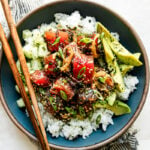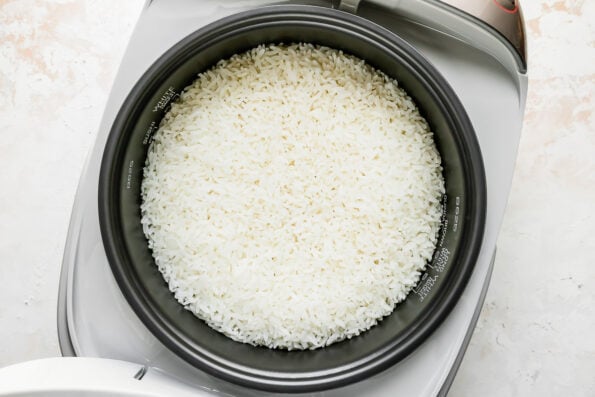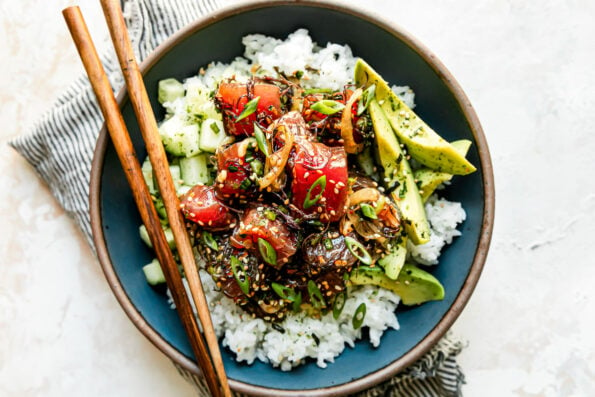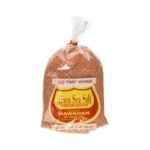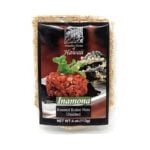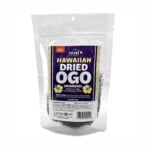Description
While they’ve exploded in popularity here on the mainland in recent years, my Hawaiian family has enjoyed poke bowls for as long as I can remember! Whether you have yet to try one or you’re looking for a quick recipe to satisfy poke bowl cravings at home, my Mom’s Ahi Tuna Poke Bowl recipe is the perfect place to start!
Inspired by the poke of Mom’s childhood in Honolulu, these bowls consist of 3 main components:
- Shoyu ahi poke, a pretty classic poke that highlights the freshness of its ingredients. Mom’s version is the best! You’ll want to take time to source the right ingredients (we have lots of guidance included in the Recipe Notes, below!), but you’ll love how they come together to easily create a poke with clean, balanced flavor. Learn more! ⇢ Mom’s Shoyu Ahi Poke.
- Rice. My family’s preferred variety is Calrose, a medium-grain white rice that’s popular in Hawaii. For best results, be sure to rinse the rice really well, prepare it in a rice cooker, & let it rest for 5-10 minutes before serving.
- Toppings. We keep things simple, using just 4 carefully considered toppings to enhance the bowls with complementary flavor & texture: cucumber adds cool crunch, avocado adds creaminess, furikake adds extra seasoning, & the littlest bit of wasabi mayo adds a spicy punch.
You’ll notice this recipe is much simpler than the colorful, toppings-loaded poke bowls you find today at poke restaurants, which is intentional. At my house, we prefer honoring the tradition of Hawaiian poke with simplicity – a little restraint creates space for the beautifully fresh flavors to shine. My hope is that once you try them, you’ll really appreciate it too. ♡
Ingredients
- 1 cup Calrose rice, rinsed well
- shoyu ahi poke, below (see Recipe Notes)
- optional: ½ English cucumber, peeled as desired & diced into ½-inch cubes
- optional: ¼ cup furikake
- optional: ⅓ cup wasabi mayo (⅓ cup mayonnaise + 1-2 teaspoons wasabi paste, to taste)
for the shoyu ahi poke:
- 1 pound sashimi-grade ahi tuna, diced into ¾-inch cubes
- ¼ large sweet onion, thinly sliced (approx. ¼ cup)
- 3 green onions, thinly sliced (approx. ⅓ cup)
- optional: 2 tablespoons dried ogo or limu (or ¼ cup rehydrated ogo or limu made from 2 tablespoons dried placed in 2.5 cups of lukewarm water). (Hawaiian seaweed, see Recipe Notes)
- 2–3 tablespoons shoyu or soy sauce (sub tamari if gluten-free)
- 1 tablespoon toasted sesame oil
- 1 teaspoon Hawaiian sea salt
- 1 teaspoon finely chopped Inamona or toasted macadamia nuts
- 1 teaspoon toasted sesame seeds
- ¾ teaspoon crushed red pepper
Instructions
- Rinse the rice: Transfer the rice to the rice cooker’s inner cooking pan. To rinse the rice, cover the rice with warm water, give it a good jostle with your hands to agitate the dust off the rice’s surface, then carefully drain the water. Repeat rinsing until the water runs clear – this takes a good minute or two; be patient! (Learn more! ⇢ How to Properly Wash Rice.) [gallery columns="2" size="full" ids="37313,37316"]
- Cook the rice: Following the ratios provided in the manufacturer’s directions, add water to the inner cooking pan. Place the inner cooking pan in the rice cooker & cook according to the manufacturer’s directions. Once the rice is done, let it steam & rest for 5-10 minutes before serving.
- Mix the poke: Meanwhile, as the rice cooks, prepare the poke. In a medium bowl, combine the cubed tuna, sliced sweet onion & green onion, ogo or limu (if using), shoyu, toasted sesame oil, Hawaiian sea salt, inamona or macadamia nuts, toasted sesame seeds, & crushed red pepper. Gently stir, combining the ingredients well. Cover & transfer to the refrigerator to marinate for at least 1 hour. (Learn more! ⇢ Mom’s Shoyu Ahi Poke Recipe.) [gallery columns="2" size="full" ids="37318,37320"]
- Poke bowl assembly: Use a rice paddle to portion the rice into individual bowls. Be sure to use the paddle to scrape the rice out of the pot rather than digging it – doing so compacts the rice & we want our poke bowl rice to be nice & light! Spoon the chilled poke over the rice, along with toppings of choice. Enjoy!
Notes
- Ingredient Notes:
- Best rice for poke bowls: For best results, use either short-grain or medium-grain white rice for your poke bowls. My family is partial to Calrose-style medium-grain white rice (preferred brands: Botan & Kokuho Rose), though sushi-style short-grain white rice can be used to make poke bowls as well.
- Shoyu ahi poke: While you can build a poke bowl using a wide variety of seafood, the shoyu ahi poke used for this poke bowl recipe is the version my mom always makes. We love it – like local-style Hawaiian poke, it’s simple, traditional, & highlights the fresh flavor of the fish. If you’d like to learn more, be sure to check out our Shoyu Ahi Poke recipe.
- Best fish for poke: As the star of any poke recipe, it’s important to use the best quality fish you can find. Since poke is a raw preparation, it’s also important to source your fish from somewhere you trust. While some swear by using only “sushi-grade fish” or “sashimi-grade fish,” these designations aren’t regulated – this is an interesting read on the matter. Rather than focusing on specific labels, I suggest heading to your local fishmonger & letting them guide you in the right direction. If you’re local to the Twin Cities Metro, I am a big fan of Coastal Seafoods – they have storefronts in both Minneapolis & St. Paul. This is also a great base recipe – if you cannot find ahi tuna, feel free to swap it for salmon or whatever looks best at the fish counter.
- Poke bowl toppings: In Hawaii, poke bowls are much simpler than the over-the-top versions that have become increasingly popular here on the mainland in recent years. Traditionally, a Hawaiian poke bowl is made by simply spooning the prepared poke over warm rice without any other toppings. But, if you’re accustomed to a more “loaded”-style poke bowl, go for it! A few of the extra add-ons we love at my house are included in the Ingredients List, above (we love the crunch of English cucumber, the oceanic flavor of furikake, & the kick of wasabi mayo), but have fun with it & pile on whatever poke bowl toppings you’re most excited about!
- Storage: Once assembled, poke bowls are best enjoyed fresh. Store any leftovers in separate airtight containers in the refrigerator for no more than 1-2 days. Reheat the rice in the microwave, then spoon the chilled poke over top.
